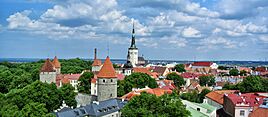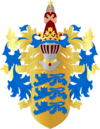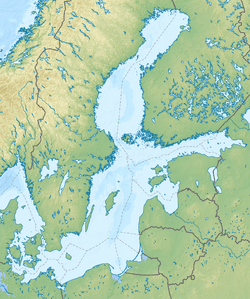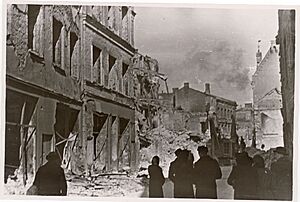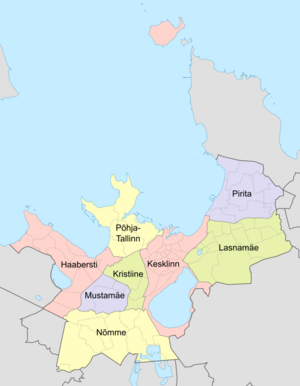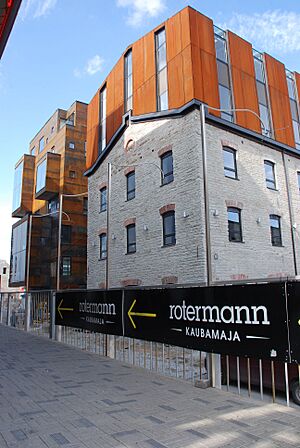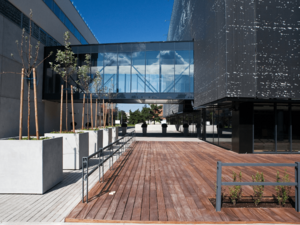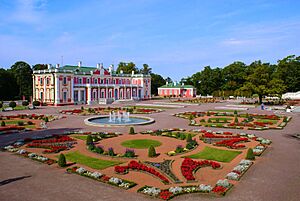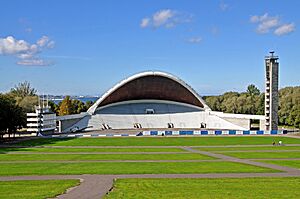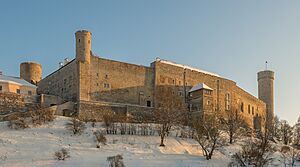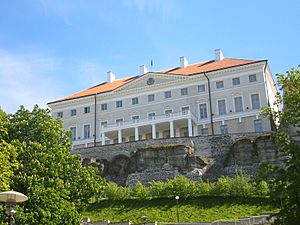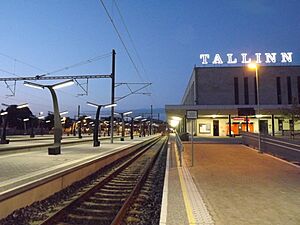Tallinn facts for kids
Quick facts for kids
Tallinn
|
|||||
|---|---|---|---|---|---|
|
Tallinn Old Town and St. Olaf's Church (middle)
Pikk Hermann
Town Hall Square
St. Nicholas Church
Freedom Square
Estonian Song Festival grounds
Kumu Art Museum
Tallinn Bay and city centre
|
|||||
|
|||||
| Country | |||||
| County | Harju | ||||
| First confirmed written record | 1219 | ||||
| First possible appearance on map | 1154 | ||||
| City rights | 1248 | ||||
| Area | |||||
| • Capital city | 159.2 km2 (61.5 sq mi) | ||||
| Elevation | 9 m (30 ft) | ||||
| Population
(2023)
|
|||||
| • Capital city | 453,864 | ||||
| • Rank | 1st in Estonia | ||||
| • Density | 2,850.9/km2 (7,380/sq mi) | ||||
| • Urban | 638,076 | ||||
| Demonym(s) | Tallinner (English) tallinlane (Estonian) |
||||
| GDP | |||||
| • Capital city | €17.369 billion (US$18.3 billion) (2022) |
||||
| • Per capita | €38,959 (US$41,055) (2022) |
||||
| Time zone | UTC+2 (EET) | ||||
| • Summer (DST) | UTC+3 (EEST) | ||||
| ISO 3166 code | EE-784 | ||||
| City budget | €1.26 billion | ||||
Tallinn is the capital and largest city of Estonia. It is located on the northern coast of Estonia, right by the Gulf of Finland and the Baltic Sea. About 461,000 people live in Tallinn (as of 2024).
Tallinn is Estonia's main center for government, money, industry, and culture. It is about 80 kilometers (50 miles) south of Helsinki, Finland. For many centuries, until the early 1900s, Tallinn was known as Reval around the world.
The city received its official city rights in 1248. However, people have lived in this area for almost 5,000 years. In the 13th century, after a battle in 1219, Denmark took control of the area. Because of its great location by the sea, Tallinn's port became a very important trading hub. This was especially true between the 1300s and 1500s. During this time, Tallinn was a key member of the Hanseatic League, a powerful group of trading cities.
Today, Tallinn Old Town is one of Europe's best-preserved medieval cities. It is recognized as a UNESCO World Heritage Site. Tallinn is also a hub for technology. Many international tech companies, like Skype and Wise, started here. The city is also home to the European Union's IT agency and NATO's Cyber Defence Centre. In 2022, Tallinn was named one of the top "medium-sized European cities of the future."
Contents
- Understanding Tallinn's Name
- A Brief History of Tallinn
- Tallinn's Geography
- Administrative Districts of Tallinn
- People of Tallinn
- Tallinn's Economy and Innovation
- Education in Tallinn
- Culture and Arts in Tallinn
- Exploring Tallinn: Top Attractions
- Getting Around Tallinn
- Famous People from Tallinn
- Sister Cities of Tallinn
- Images for kids
- See also
Understanding Tallinn's Name
The name Tallinn comes from the Estonian words Taani-linna. This means "Danish-castle." People believe this name came about because Danish invaders built a castle here after a battle in 1219.
An old Icelandic story from the 1200s mentions a place called Rafala near Tallinn. This name likely came from Rävala, an old Estonian county. After the Danish took over in 1219, the city became known as Reval in Scandinavian and German languages. This name was used officially in Estonia until 1918.
After Estonia became independent in 1918, the Estonian name Tallinn slowly replaced Reval.
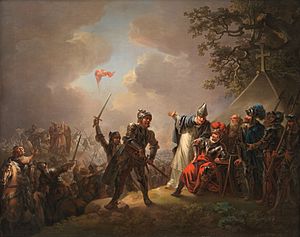
An old chronicle from around 1229 called the town Lindanisa. This name was also used by Scandinavians.
In 1154, an Arab mapmaker named Muhammad al-Idrisi described a town called Qlwn. He said it was "a small town like a large castle" in the area of 'Astlanda'. Some think this might have been an early version of Tallinn.
A Brief History of Tallinn
The first signs of people living in Tallinn's city center are about 5,000 years old. Around 1050 AD, a fortress was built on Toompea hill.
As an important port, Tallinn was a target for groups like the Teutonic Knights and Kingdom of Denmark. They wanted to expand their power and bring Christianity to the local people in the early 1200s. Danish rule began in Tallinn in 1219.

In 1285, Tallinn (then called Reval) became the northernmost member of the Hanseatic League. This was a strong group of trading and military cities. In 1346, the King of Denmark sold Reval to the Teutonic Knights. Reval was a very important port in the Gulf of Finland. It was a key trading point between Western Europe and the East. The city had about 8,000 people and was well-protected by city walls and 66 defense towers.
In 1530, a weather vane shaped like an old warrior, called Old Thomas, was placed on top of the Tallinn Town Hall. Old Thomas later became a symbol of the city.
In 1561, Tallinn became part of Sweden. During the Great Northern War (1700–1721), Tallinn became part of Tsardom of Russia in 1710. However, the local government kept some of its cultural and economic freedom.
On February 24, 1918, Estonia declared its independence in Tallinn. Tallinn then became the capital of independent Estonia. During World War II, Estonia was first taken over by the Soviet army in 1940. Then, Nazi Germany occupied it from 1941 to 1944. Tallinn suffered from many air bombings by the Soviet air force. The worst bombing was on March 9–10, 1944. Over a thousand bombs were dropped, causing huge fires and leaving many people homeless. After the Germans left, the Soviet Union took over again in September 1944.
For the 1980 Summer Olympics, the sailing events were held in Pirita, a district in Tallinn. Many new buildings were constructed for the Olympics, like the Tallinn TV Tower and the "Olümpia" hotel.
In 1991, Estonia became an independent democratic nation again. Tallinn quickly grew into a modern European capital. The Old Town became a World Heritage Site in 1997. Tallinn was also the European Capital of Culture in 2011. In 2023, it received the European Green Capital Award. The city aims to reduce greenhouse gas emissions by 40% by 2030.
Tallinn's Geography
Tallinn is located on the southern coast of the Gulf of Finland. This is in the northwestern part of Estonia.
The largest lake in Tallinn is Lake Ülemiste. It covers about 9.44 square kilometers (3.64 square miles). This lake provides most of the city's drinking water. Lake Harku is the second largest lake in Tallinn. The only important river in Tallinn today is the Pirita River, which flows through the Pirita district.
The coastline of Tallinn is 46 kilometers (29 miles) long. It has three larger peninsulas: Kopli, Paljassaare, and Kakumäe. The city also has several public beaches, including Pirita and Stroomi.
The highest point in Tallinn is 64 meters (about 200 feet) above sea level. It is located in the Hiiu area of the Nõmme District. A large limestone cliff runs through the city. You can see it at Toompea, Lasnamäe, and Astangu.
Tallinn's Climate
Tallinn has a climate with warm, rainy summers and cold, snowy winters.
Winters are cold but not as harsh as some other places at the same latitude. This is because of its location by the sea. The average temperature in February, the coldest month, is about -3.6°C (25.5°F). Snow is common in winter, and there isn't much sunshine. In December, daylight lasts for less than 6 hours.
Spring starts cool, but it gets warmer and sunnier in May. Daytime temperatures in May average 15.4°C (59.7°F). Freezing temperatures can still happen in March and April.
Summers are warm, with daytime temperatures usually between 19.2°C (66.6°F) and 22.2°C (72.0°F). July is usually the warmest month, averaging 17.6°C (63.7°F). Summers are the sunniest time of year. In June, daylight lasts for more than 18 hours and 40 minutes.
Autumn begins mild in September, then gets cooler and cloudier by November. Snow can fall in October, and freezing temperatures become more common in November.
Tallinn gets about 700 mm (28 inches) of rain each year. It rains fairly evenly throughout the year. March, April, and May are the driest months. July and August are the wettest. Tallinn is known for its unpredictable weather.
Administrative Districts of Tallinn
Tallinn is divided into eight administrative districts called linnaosa. Each district has its own local government. These governments advise the city on matters related to their areas.
The districts are further divided into 84 smaller areas called asum, which are like neighborhoods.
People of Tallinn
| Historical population | ||
|---|---|---|
| Year | Pop. | ±% |
| 1372 | 3,250 | — |
| 1772 | 6,954 | +114.0% |
| 1816 | 12,000 | +72.6% |
| 1834 | 15,300 | +27.5% |
| 1851 | 24,000 | +56.9% |
| 1881 | 45,900 | +91.3% |
| 1897 | 58,800 | +28.1% |
| 1925 | 119,800 | +103.7% |
| 1959 | 283,071 | +136.3% |
| 1970 | 362,706 | +28.1% |
| 1979 | 428,537 | +18.1% |
| 1989 | 478,974 | +11.8% |
| 2000 | 400,150 | −16.5% |
| 2011 | 393,222 | −1.7% |
| 2021 | 437,817 | +11.3% |
As of January 1, 2024, Tallinn's population was 461,346. It is the largest city in Estonia. It is also the third most populated city in the Baltic States (Estonia, Latvia, Lithuania).
Before World War II, over 80% of Tallinn's population was Estonian. However, during the time of Soviet control, many people from Russia and other parts of the Soviet Union moved to Tallinn. This changed the city's ethnic makeup. As of 2022, Estonians make up over 53% of the population. Russians are a large minority, making up about a third of the residents.
The official language of Tallinn is Estonian. In 2011, about 50.1% of residents spoke Estonian as their first language. About 46.7% spoke Russian as their first language. English is the most common foreign language spoken.
| Ethnicity | 1922 | 1934 | 1941 | 1959 | 1970 | 1979 | 1989 | 2000 | 2011 | 2021 | ||||||||||
|---|---|---|---|---|---|---|---|---|---|---|---|---|---|---|---|---|---|---|---|---|
| Number | % | Number | % | Number | % | Number | % | Number | % | Number | % | Number | % | Number | % | Number | % | Number | % | |
| Estonians | 102,568 | 83.9 | 117,918 | 85.6 | 132,396 | 94.0 | 169,697 | 60.2 | 201,908 | 55.7 | 222,218 | 51.9 | 227,245 | 47.4 | 215,114 | 53.7 | 217,601 | 55.3 | 233,520 | 53.3 |
| Russians | 7,513 | 6.14 | 7,888 | 5.72 | 5,689 | 4.04 | 90,594 | 32.2 | 127,103 | 35.0 | 162,714 | 38.0 | 197,187 | 41.2 | 146,208 | 36.5 | 144,721 | 36.8 | 149,883 | 34.2 |
| Ukrainians | – | – | 35 | 0.03 | – | – | 7,277 | 2.58 | 13,309 | 3.67 | 17,507 | 4.09 | 22,856 | 4.77 | 14,699 | 3.67 | 11,565 | 2.94 | 15,450 | 3.53 |
| Belarusians | – | – | – | – | – | – | 3,683 | 1.31 | 7,158 | 1.97 | 10,261 | 2.39 | 12,515 | 2.61 | 7,938 | 1.98 | 6,229 | 1.58 | 6,154 | 1.41 |
| Finns | – | – | 304 | 0.22 | 214 | 0.15 | 1,650 | 0.59 | 2,852 | 0.79 | 2,996 | 0.70 | 3,271 | 0.68 | 2,436 | 0.61 | 2,062 | 0.52 | 3,431 | 0.78 |
| Jews | 1,929 | 1.58 | 2,203 | 1.60 | 0 | 0.00 | 3,714 | 1.32 | 3,750 | 1.03 | 3,737 | 0.87 | 3,620 | 0.76 | 1,598 | 0.40 | 1,460 | 0.37 | 1,405 | 0.32 |
| Latvians | – | – | 572 | 0.42 | 340 | 0.24 | 702 | 0.25 | 1,007 | 0.28 | 1,259 | 0.29 | 1,032 | 0.22 | 827 | 0.21 | 628 | 0.16 | 1,500 | 0.34 |
| Germans | 6,904 | 5.65 | 6,575 | 4.77 | – | – | 125 | 0.04 | 217 | 0.06 | 332 | 0.08 | 516 | 0.11 | 516 | 0.13 | 492 | 0.13 | 1,219 | 0.28 |
| Tatars | – | – | 75 | 0.05 | – | – | 745 | 0.26 | 1,055 | 0.29 | 1,500 | 0.35 | 1,975 | 0.41 | 1,265 | 0.32 | 1,012 | 0.26 | 1,033 | 0.24 |
| Poles | – | – | 599 | 0.43 | 502 | 0.36 | 759 | 0.27 | 967 | 0.27 | 1,084 | 0.25 | 1,240 | 0.26 | 936 | 0.23 | 768 | 0.20 | 940 | 0.21 |
| Lithuanians | – | – | 92 | 0.07 | 97 | 0.07 | 594 | 0.21 | 852 | 0.23 | 905 | 0.21 | 1,052 | 0.22 | 949 | 0.24 | 795 | 0.20 | 1,092 | 0.25 |
| Unknown/Not stated | 0 | 0.00 | 368 | 0.27 | 150 | 0.11 | 0 | 0.00 | 0 | 0.00 | 1 | 0.00 | 7 | 0.00 | 3,694 | 0.92 | 709 | 0.18 | 4,317 | 0.99 |
| Other | 3,354 | 2.74 | 1163 | 0.84 | 1,523 | 1.08 | 2,174 | 0.77 | 2,528 | 0.70 | 4,023 | 0.94 | 6,458 | 1.35 | 4,198 | 1.05 | 5,180 | 1.32 | 17,873 | 4.08 |
| Total | 122,268 | 100 | 137,792 | 100 | 140,911 | 100 | 281,714 | 100 | 362,706 | 100 | 428,537 | 100 | 478,974 | 100 | 400,378 | 100 | 393,222 | 100 | 437,817 | 100 |
| Ethnic group | Population (2022) | % |
|---|---|---|
| Estonians | 233,518 | 53.34 |
| Russians | 149,878 | 34.23 |
| Ukrainians | 15,449 | 3.53 |
| Belarusians | 6,153 | 1.40 |
| Finns | 3,431 | 0.78 |
| Jews | 1,405 | 0.32 |
| Latvians | 1,343 | 0.34 |
| Germans | 1,219 | 0.28 |
| Lithuanians | 1,092 | 0.25 |
| Armenians | 1,043 | 0.24 |
| Tatars | 1,033 | 0.24 |
| Azerbaijanis | 1,029 | 0.23 |
| Poles | 940 | 0.21 |
| Other | 15,960 | 3.64 |
| Unknown | 4,318 | 0.99 |
Tallinn's Economy and Innovation
Tallinn has a strong and varied economy. It is especially good at information technology, tourism, and logistics. More than half of Estonia's total economic output (GDP) comes from Tallinn.
Tallinn is known as a "Silicon Valley on the Baltic Sea" because of its growing tech sector. Many successful tech companies, like Skype and Wise, started here. The city is also home to important IT centers for the European Union and NATO.
Tallinn welcomes about 4.3 million visitors every year. This number has been growing steadily. Many tourists come from Europe, but more and more are visiting from Asia. The Tallinn Passenger Port is one of the busiest cruise destinations in the Baltic Sea.
Tallinn is Estonia's financial center. Many big banks, like SEB and Swedbank, have offices here. The Tallinn Stock Exchange is the only stock exchange in Estonia.
The Port of Tallinn is one of the largest ports in the Baltic Sea region. While the Old City Harbour is historic, most cargo operations now happen at the larger Port of Muuga nearby. Tallinn's industries include shipbuilding, machine building, and electronics.
Major Companies and Organizations
Many important organizations and companies have their main offices or major centers in Tallinn. These include:
- NATO Cooperative Cyber Defence Centre of Excellence (CCDCOE)
- eu-LISA, the EU Digital Agency
- Skype software development center
- Telia Company IT development center
- Ericsson (one of its largest production facilities in Europe)
- Bolt (a popular transportation company)
Education in Tallinn
Tallinn has many important universities and science institutions. These include:
- Tallinn University
- Tallinn University of Technology
- Estonian Academy of Arts
- Estonian Academy of Music and Theatre
- Estonian Business School
Culture and Arts in Tallinn
Tallinn was a European Capital of Culture in 2011. This means it was chosen to showcase its cultural life.
Museums to Explore
Tallinn has over 60 museums and galleries. Most of them are in the central district, Kesklinn. They cover Tallinn's rich history and art.
The Estonian History Museum is in the Old Town. It tells the story of Estonia from ancient times to the late 1900s. The Estonian Maritime Museum shows the nation's history with the sea. It is located inside Fat Margaret's Tower, an old defense structure.
The Tallinn City Museum covers the city's history from ancient times until Estonia regained independence in 1991. It also has other museums, like the Museum of Photography.
The Vabamu Museum of Occupations and Freedom tells the story of Estonia's occupation by the Soviet Union and Nazi Germany. The KGB Museum also shares information about the Soviet secret service.
Tallinn has several art and design museums. The Art Museum of Estonia is the largest art museum. It has four branches, including the Kumu Art Museum. Kumu has the country's largest collection of modern art. The Kadriorg Art Museum displays Western European and Russian art. The Mikkel Museum shows a collection of Western art and Chinese porcelain. The Niguliste Museum displays religious art from the Middle Ages.
Estonian Song Festival
The Estonian Song Festival (Laulupidu) is one of the world's largest choir events. It happens every five years in July at the Tallinn Song Festival Grounds. Over 30,000 singers perform for an audience of 80,000 people. This festival is recognized by UNESCO as a "Masterpiece of the Oral and Intangible Heritage of Humanity."
Estonians have a huge collection of folk songs, with about 133,000 recorded. In 1988, 300,000 people gathered in Tallinn for a song festival. They sang national songs that were forbidden during Soviet times. This peaceful protest was part of the "Singing Revolution."
Tallinn Black Nights Film Festival
The Tallinn Black Nights Film Festival (PÖFF) is an annual film festival. It is held in Tallinn every year since 1997. PÖFF is the only festival in the Nordic and Baltic region that can hold an international film competition. It screens over 250 feature films each year. It is one of the largest film events in Northern Europe.
Tallinn's Cuisine
Tallinn's traditional food shows its history as a fishing port and German influences. Cafés and bars have been important parts of the city's social life for a long time.
Martsipan (marzipan) has a long history in Tallinn. It was first made in the Middle Ages. In 1695, marzipan was even sold as medicine in the Tallinn Town Hall Pharmacy. Today, the Maiasmokk café is famous for its marzipan.
A very special seafood dish in Tallinn is vürtsikilu ("spicy sprat"). These are salted sprats pickled with unique spices. A popular snack is kiluvõileib ("sprat-butter-bread"). This is an open sandwich with butter and spicy sprats on rye bread.
Exploring Tallinn: Top Attractions
Tallinn's main attractions are in the Tallinn Old Town. This area is easy to explore on foot. Other popular places include Pirita and Kadriorg. The Estonian Open Air Museum shows Estonian rural culture. Historic neighborhoods like Kalamaja and revitalized industrial areas are also interesting to visit.
Toompea – The Upper Town
Toompea was once a separate, heavily fortified town. It has always been the center of power in Estonia. The hill is easy to defend and overlooks the city. Key sights here include the medieval Toompea Castle, which now houses the Estonian Parliament. You can also see the Lutheran St Mary's Cathedral and the Russian Orthodox Alexander Nevsky Cathedral.
All-linn – The Lower Town
This area is one of Europe's best-preserved medieval towns. The city is working to keep it in good condition. Important sights include the Town Hall Square. You can also walk along the city wall and see its towers. Famous towers include "Fat Margaret" and "Kiek in de Kök." There are also several medieval churches, like St Olaf's and St. Nicholas'.
Kadriorg District
Kadriorg is about 2 kilometers (1.2 miles) east of the city center. You can get there by bus or tram. Kadriorg Palace was built for Peter the Great. It now holds the foreign art collection of the Art Museum of Estonia. The palace grounds have beautiful gardens and woodlands.
The main building of the Art Museum of Estonia, Kumu, is in Kadriorg park. It has a large collection of Estonian art, from the 1700s to today.
Pirita District
Pirita is a coastal district about 2 kilometers (1.2 miles) northeast of Kadriorg. The marina here was built for the 1980 Summer Olympics. You can rent boats on the Pirita River. The Botanic Gardens and the Tallinn TV Tower are also in Pirita.
Getting Around Tallinn

City Public Transport
Tallinn has a public transport system with buses (73 lines), trams (5 lines), and trolley-buses (4 lines). This system covers all parts of the city. The tram system is the only one in Estonia.
Since January 2013, Tallinn has offered free public transport within the city limits. This is for residents who register with the city.
Air Travel
The Lennart Meri Tallinn Airport is about 4 kilometers (2.5 miles) from the Town Hall Square. You can take a tram (Line Number: 4) or a local bus (No. 2) to get to the city center.
Ferry Services
Several ferry companies connect Tallinn to other cities. You can take a ferry to Helsinki, Mariehamn, Stockholm, and St. Petersburg. Ferries to Helsinki take about 2 to 3.5 hours. There are up to eight crossings daily all year round.
Train Travel
The Elron railway company runs train services from Tallinn to many Estonian cities. These include Tartu, Narva, and Viljandi. Tallinn also has commuter trains that run to nearby towns.
The Rail Baltica project will connect Tallinn to Warsaw, Poland, through Latvia and Lithuania. This will link Tallinn to the rest of the European rail network. There is also a plan for an undersea tunnel between Tallinn and Helsinki.
Roads and Highways
The Via Baltica motorway connects Tallinn to the Lithuanian-Polish border. This road is part of European route E67, which goes from Helsinki to Prague.
Famous People from Tallinn
Tallinn has been home to many notable people throughout history. These include artists, writers, politicians, and athletes.
Artists and Writers
- Michael Sittow (around 1469–1525), a famous Estonian painter.
- Kristjan Raud (1865–1943), a symbolist painter known for his unique style.
- Anton Hansen (1878–1940), a writer whose book Truth and Justice is considered "The Estonian Novel."
- Marie Under (1883–1980), a poet nominated many times for the Nobel Prize in literature.
- Jaan Kross (1920–2007), a novelist also nominated for the Nobel Prize.
- Jüri Arrak (1936–2022), a well-known Estonian artist and painter.
Politicians and Leaders
- Lennart Georg Meri (1929–2006), the second President of Estonia from 1992 to 2001.
- Andres Tarand (born 1940), a former Prime Minister of Estonia.
- Juhan Parts (born 1966), Prime Minister of Estonia from 2003 to 2005.
- Marina Kaljurand (born 1962), a politician and former Minister of Foreign Affairs.
Sports Figures
- Gerd Kanter (born 1979), a famous discus thrower.
- Mart Poom (born 1972), a well-known footballer and coach.
- Anett Kontaveit (born 1995), a tennis player who is the highest-ranked Estonian singles player ever.
- Jüri Vips (born 2000), a racing driver.
Sister Cities of Tallinn
Tallinn is twinned with many cities around the world. This means they have special partnerships to promote cultural and economic ties. Some of Tallinn's sister cities include:
Images for kids
-
The Old Thomas weather vane was put on top of Tallinn Town Hall in 1530 and is the city's symbolic guardian.
See also
 In Spanish: Tallin para niños
In Spanish: Tallin para niños


